
Therapeutic Efficacy of Methanol Extract of Bidens tripartita in HT22 Cells by Neuroprotective Effect
Abstract
Oxidative stress brings about apoptosis through various mechanisms. In particular, oxidative stress in neuronal cells can causes a variety of brain diseases. This study was conducted to investigate the effect of Bidens tripartita on oxidative stress in neuronal cells. B. tripartita has traditionally been used in Russia as a medicine for diseases such as rhinitis, angina and colitis. Over-production of glutamate induces oxidative stress. When the oxidative stress occurs in the cells, reactive oxygen species (ROS) and Ca2+ increase. In addition, the abrupt decline of mitochondrial membrane potential and the decrease of glutathione related enzymes such as glutathione reductase (GR) and glutathione peroxidase (GPx) are also observed. The samples used in the experiment showed cytoprotective effect in the MTT assay. It also lowered the ROS and Ca2+ level, and increased degree of mitochondrial membrane potential, GR and GPx. As a result, B. tripartita had a positive effect against oxidative stress. Thus, it is expected to have potential for treatment and prevention of degenerative brain diseases such as Alzheimer’s disease.
Keywords:
Bidens tripartite, Alzheimer’s disease, HT22 cell, Oxidative stress, GlutathioneIntroduction
Alzheimer’s Disease (AD) is the most common form of dementia, a neurodegenerative disease.1 This disease is accompanied by memory and behavioral disorders. Causes of AD include various biological processes such as abnormal deposition of amyloid-beta (Aβ) peptide, accumulation of neurofibrillary tangles (NFTs), deficiency or insufficient synthesis of neurotransmitters, oxidative stress, and genetic and environmental factors.2 Glutamate is an excitatory neurotransmitter that is present in the central nervous system and affects memory and learning abilities.3,4 Glutamate overdose in vivo contributes to brain damage.5 Under conditions that can damage the brain, such as hypoxia, the glutamate concentration in the brain increases up to 50 times.6 Glutamate in the brain with increased concentration is a cause of degenerative brain disease. Glutamate over expression increases the production of reactive oxygen species (ROS) in the cell and results in apoptosis.7 Glutathione (GSH) plays a role in cushioning ROS, and consists of glutamate, cysteine, glycine.8 Glutamate makes glutathione (GSH) and activity of glutathione reductase (GR), glutathione peroxidase (GPx) which plays an important role in GSH's mechanisms decrease.9 It also causes mitochondrial dysfunction and excessively increases Ca2+ concentration.10 These phenomena lead to oxidative stress causing to cell damage. In addition, damage to cells in neuronal cells can lead to degenerative diseases. Overall, oxidative stress and excess glutamate can contribute to the development and progression of neurological diseases, making them important targets for therapeutic intervention.
Bidens tripartita has traditionally been used in Russia as a medicine for diseases such as rhinitis, angina and colitis and it also became a material for the treatment of dysentery herbal medicine.11 B. tripartita, an annual plant of Asteraceae, contains components such as flavonoids, coumarins, polysaccharides and carotenoids.12 From these, we supposed that B. tripartita has anti-inflammatory effect. Reducing neuroinflammation is a promising therapeutic strategy for Alzheimer’s disease. Various anti-inflammatory drugs and natural compounds have been investigated for their potential to reduce neuroinflammation and improve cognitive function in AD.13 In this study, we have examined the effects of B. tripartita as a natural treatment for AD through several activity experiments.
Natural products have infinite possibilities to contain unknown compounds, including already known compounds. The treatment of disease using natural product has been studied steadily. The use of natural products is less of a side effect than using compounds obtained through synthesis. Indeed, natural products are in many cases an important source of bioactive materials as therapeutic agents.14 We conducted experiments to determine the possibility that B. tripartita could be used for the treatment and prevention of degenerative brain disease such as AD.
Experimental
Plant materials and extract preparation ㅡ The dried leaves of Bidens tripartita were purchased from kyungdongmarket (Seoul, Korea). The leaves of B. tripartita were extracted with 80% MeOH by 9 times for 60 min with ultrasonicator. The extract was concentrated under reduced pressure and obtained a solid form.
Cell culture and in vitro test reagents ㅡ Dulbecco’s modified eagle’s medium (DMEM), fetal bovine serum (FBS), penicillin/streptomycin, Hank’s balanced salt solution and trypsin-EDTA for cell culture were purchased from Gibco BRL Co, (U.S.A). Glutamate, 6-Hydroxy-2,5,7,8-tetramethylchroman-2-carboxylic acid (Trolox), 3-(4,5-dimethylthiazol-2-yl)-2,5-diphenyltetrazolium bromide (MTT), DMSO, sodium bicarbonate (NaHCO3), HEPES, 2’,7’-dichlorofluorescin, L-GSH reduced, L-GSH oxidized, hydrogen peroxide solution, rhodamine 123, 5’,5’-dithiobis (2-nitrobenzoic acid) and triton X-100 were obtained from sigma (U.S.A). Fura 2-AM was purchased from Dojindo (U.S.A). 0.2 μm membrane filter was purchased from ADVANTEC in Japan.
Cell culture ㅡ HT22 cell line derived from mouse hippocampus was used for the experiment. Cell viability was measured in glutamate-induced apoptosis using HT22 cells. Cells were cultured in DMEM containing 10% (v/v) fetal bovine serum (FBS), 1% penicillin/streptomycin, NaCO3 (2 mg/mL), and 15 mM HEPES, and incubated at 37 oC humidified with 5% CO2.
Cell viability ㅡ HT22 cells were seed at 1.7 × 104 /well in 48-well plates and cultured for 24 h (at 37 oC, humidified 5% CO2). For the control and negative control groups, add 300 μl of DMEM, 300 μl of trolox for positive control. The remaining wells receive 300 μl of diluted B. tripartita extract. (1, 20, 50 μg/mL). After 1 h incubation, all wells except control group are treated with 3 mM glutamate and 300 μl of DMEM was added to control group and all cells were incubated. After 23 h, 1 μg/mL MTT solution was treated to each well for 3 h and MTT formazan was dissolved by dimethyl sulfoxide (DMSO). The optical density (OD) was measured using an ELISA at 570 nm. The neuroprotective activity of samples was determined by relative protection (%); Relative protection = (OD of glutamate-treated with sample group − OD of only glutamate-treated group)/(OD of control group − OD of only glutamate-treated group) × 100.
Measurement of intracellular ROS levels ㅡ The cultured HT22 cells were treated with glutamate, trolox, samples which were diluted B. tripartita extract and cultured at 37 oC. After 8 h, 40 μl of 100 μM DCF-DA was added and cultured for 1 h. After that, the medium was removed and dissolved in 300 μl of 1.0% triton X-100 for 15 min at 37 oC. Fluorescence was measured twice at excitation wavelength (490 nm), emission wavelength (525 nm).
Measurement of Ca2+ levels ㅡ The cultured HT22 cells were treated with trolox and samples which were diluted B. tripartita extract, and 10 μl of 20 μM Fura-AM was added to all wells. After incubation for 1 h, glutamate was treated and cultured at 37 oC for 2 h. After incubation, the medium was removed and dissolved in 150 μl of 1.0% Triton X-100 at 37 oC for 15 min. Fluorescence was measured twice in calcium complex (340 nm), calcium free (510 nm).
Measurement of mitochondrial membrane potential ㅡ The cultured HT22 cells were treated with each concentration of samples which were diluted B. tripartita extract and added to 3 mM glutamate for 1 h to induce apoptosis. 10 μl of Rhodamine123 was added, incubated at 37 oC for 30 min, and washed three times with PBS. Fluorescence is measured twice at extraction wavelength (480 nm), emission wavelength (525 nm).
Measurement of glutathione reductase and glutathione peroxides ㅡ The cultured HT22 cells were treated with glutamate, trolox and B. tripartita extract at different concentrations. After 8 h, it was washed with phosphate buffer solution of 0.2 M, pH 7.4. After that, the washed cells were dissolved with sulfosalicylic acid, centrifuged (at 4 oC, for 30 min, 3000 g) and the supernatant was collected. GR is an enzyme that catalyzes the reduction of glutathione disulfide (GSSG) to GSH in a NADPH dependent manner. Therefore, GR was measured as the amount of GSSG reduced in the presence of NADPH. Conversely, GPx was tested using the degree of oxidation of GSH to GSSG. The results of experiments were recorded as absorbance at 340 nm.
Statistical analysis ㅡ The data of experiments were presented as mean ± SD, respectively. All experimental results were statistically analyzed using one-way ANOVA and Tukey’s post hoc test with IBM SPSS Statistics software V26 (IBM, Armonk, NY, US) and Microsoft Excel software (Microsoft). The differences between the experimental groups were significant at p < 0.05, 0.01 and 0.001 level, respectively.
Results and discussion
HT22 cells, a hippocampus-derived cell line used in CNS-related experiments was determined as an experimental subject. We used glutamate and trolox, mechanisms already known to study the cytoprotective activity of B. tripartita. Elevation of glutamate causes oxidative stress and apoptosis.15 Neuronal cell death may lead to memory and learning disorders and ultimately to neurodegenerative brain diseases.16 We investigated the cytoprotective effects of B. tripartita on glutamate-induced neurotoxicity through the MTT assay. These experiments confirmed that B. tripartita has cell protective effect on glutamate-induced cytotoxicity in HT22 cells, Low concentration of B. tripartita had similar protective effect as glutamate used as a negative control. In HT22 cell, neuroprotective effect of B. tripartita was detected on glutamate-induced cytotoxicity (Fig. 1). The study showed that about 65.42% of cells subjected to glutamate injury remained viable compared to untreated cells. However, pretreatment with increasing doses of B. tripartita (10, 20, and 50 μg/mL) gradually improved cell viability in a dose-dependent manner. At concentrations of 20 and 50 μg/mL, B. tripartita exhibited a significant neuroprotective activity, with relative protective percentages of 32.15% and 70.28%, respectively. Notably, at a concentration of 50 μg/mL, B. tripartita exhibited the most potent neuroprotective activity, similar to that of the positive control, trolox.
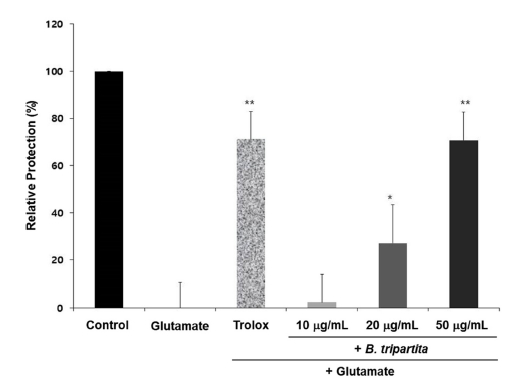
The relative protection of B. tripartita against glutamate induced toxicity in HT22 cells. Cells were pretreated with 10, 20, and 5 0 μg/mL of B. tripartita and trolox as positive control. Then 3 mM glutamate was treated after 1 h. Each bar represents the Mean ± S.D. of three independent experiments. *p < 0.05, **p < 0.01, ***p < 0.001 versus glutamate injured cells.
Overflowing of glutamate causes accumulation of ROS.7 We confirm the degree of inhibition of ROS through fluorescence measurement (Fig. 2). A control treated group was rated as 0% and a group of glutamate treated was rated as 100%. Trolox lowered the ROS level to 14.88 ± 1.81%. 10 μg/mL B. tripartita increases the ROS level as much as the result of the negative control, 94.84 ± 2.25%. In concentration of 20 μg/m, the ROS level decreased but that was only marginal to 84.24 ± 1.81%. Highest concentration of B. tripartita, 50 μg/mL, made ROS level low significantly. The antioxidative effect of B. tripartita was found to be almost the same as that of trolox at the highest concentration. In the human body, ROS is produced due to various stresses. ROS in the brain may lead to degenerative brain diseases such as AD.17 These ROS can be controlled through balance with antioxidants. We examined whether B. tripartita functions as an antioxidant to affect the reduction of ROS. Low concentration of B. tripartita did not seem to have contributed to the reduction of ROS in the outcome. However, as the concentration of ROS decreased rapidly at high concentration, the antioxidant effect was increased and the amount of ROS decreased.
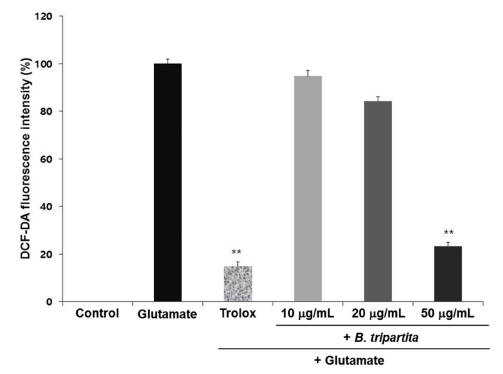
The intracellular ROS amount of B. tripartita against glutamate toxicity in HT22 cells. Cells were pretreated with 10, 20, and 50 μg/mL of B. tripartita and trolox as positive control. Then 3 mM glutamate was treated after 1 h. Each bar represents the Mean ± S.D. of three independent experiments. *p < 0.05, **p < 0.01, ***p < 0.001 versus glutamate injured cells.
Oxidative stress and Ca2+ are strongly associated with glutamate-induced apoptosis.18 Glutamate increases the uptake of Ca2+ through the activation of the NMDA receptor, Ca2+ membrane channel, leading to cell death.19 Compared with the result of glutamate, B. tripartita samples showed significant results from 20 μg/mL to high concentrations. It was less than trolox, the high-concentration sample was as effective as trolox. It was only about 7% different from trolox. Thus, we can confirm that B. tripartita was effective in lowering the rate of Ca2+ growth due to glutamate. Glutamate makes Ca2+ concentration increase. Cells that did not process anything were set to 0%, glutamate treated cells were set at 100% as the standard. The level of fluorescence was 14.88 ± 1.81% at trolox treated cells. At lowest concentration, 10 μg/mL, the calcium level was not as great as 82.90 ± 2.64%. But the higher concentration, the greater cell protection effect. At concentration of 20 μg/mL, cell protection did not show a strong effect at 44.84 ± 2.8% but was more effective at 10 μg/mL. And the result of highest concentration was similar with positive control, 24.67 ± 1.1%. As a result, significantly cell protection effect was observed at 20 μg/mL and 50 μg/mL (Fig. 3).
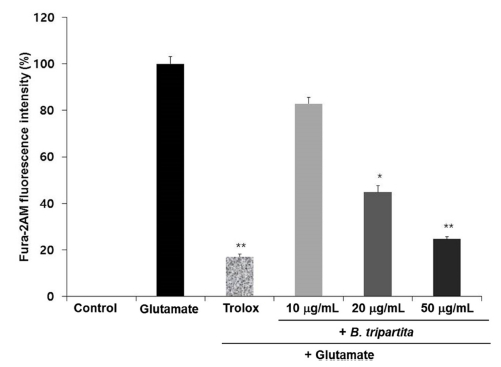
The intracellular Ca2+ amount of B. tripartita against glutamate toxicity in HT22 cells. Cells were pretreated with 10, 20, and 50 μg/mL of B. tripartita and trolox as positive control. Then 3 mM glutamate was treated after 1 h. Each bar represents the Mean ± S.D. of three independent experiments. *p < 0.05, **p < 0.01, ***p < 0.001 versus glutamate injured cells.
Mitochondrial membrane potential is thought to be related to necrosis or apoptosis, and many researchers are studying the relationship between mitochondria and cell survival.20 Glutamate causes an immediate decrease in mitochondrial membrane potential.21 We conducted an experiment to determine the effect of B. tripartita on glutamate-induced mitochondrial membrane potential changes. As with previous experiments, low concentration of B. tripartita did not show any significant effect. However, the higher concentration, the less decreased in mitochondrial membrane potential. At high concentration, there was no strong effect on the increase of mitochondrial membrane potential, but it showed significant results. Through our experiment, we confirmed that B. tripartita had a cytoprotective effect against the mechanisms leading to glutamate-induced depolarization of mitochondrial membrane potential. Glutamate reduced mitochondrial membrane potential. We detected the protection degree of B. tripartita in HT22 cells (Fig. 4). Trolox has a protective effect against glutamate induced mitochondrial membrane potential reduction. As a result, in trolox treated cells, mitochondrial membrane potential was decreased to 92.26 ± 2.33%. B. tripartita at 10 μg/mL had no obvious effect to 9.74 ± 0.55%. But the concentration of B. tripartita was higher, the mitochondrial membrane potential level increased. At the concentration of 20 μg/mL, mitochondrial membrane potential was 47.00 ± 1.2% and at 50 μg/mL, mitochondrial membrane potential was 61.89 ± 0.17%. The result of the highest concentration had a greatest effect in B. tripartita but it was not so effective.
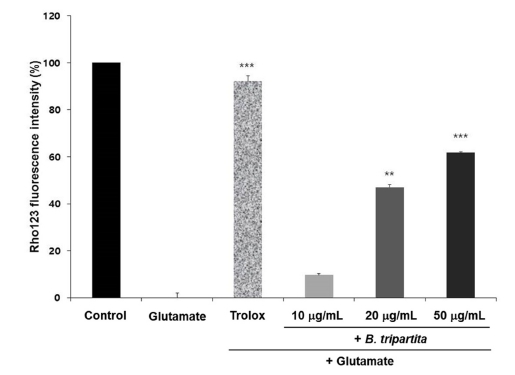
The mitochondrial membrane potential level of B. tripartita against glutamate toxicity in HT22 cells. Cells were pretreated with 10, 20, and 50 μg/mL of B. tripartita and trolox as positive control. Then 3 mM glutamate was treated after 1 h. Each bar represents the Mean ± S.D. of three independent experiments. *p < 0.05, **p < 0.01, ***p < 0.001 versus glutamate injured cells.
The decrease in glutathione reductase (GR) and glutathione peroxidase (GPx) leads to depletion of glutathione, which inhibits the entry of cysteine into cells and causes neuronal cell death.22 Glutamate causes the decrease of GR, GPx and obstructs generation of glutathione. We experimented about how B. tripartita affects the activity of GR and GPx. Low concentration of B. tripartita did not have a much effect in both GR, GPx. The concentration higher, the activity increased. Especially in GPx, the relative activity increased about three times when increased at high concentration. It was also found that the highest concentration of both GR and GPx was significant. As a result of two experiments showed that B. tripartita increased the activity of GR and GPx against glutamate-induced stress and consequently could prevent the decrease of glutathione. We detected B. tripartita's effect on GR and GPx (Fig. 5). GR and GPx are enzymes that play an important role in glutathione production3. Glutamate overflowed made GR and GPx activity decrease. At concentration of 10 μg/mL, B tripartita had only 9.07 ± 4% cell protection effect on GR and 4.38 ± 3.34% on GPx. The higher the concentration of B. tripartita, the stronger cytoprotective effect. At 20 μg/mL, it showed 28.58 ± 1.94%, 15.86 ± 2.22% cell protective activity in GR and GPx, respectively. B. tripartita of 50 μg/mL did not reach trolox but had relatively high protective activity, 50.39 ± 4.74%, 44.77 ± 3.67% each.
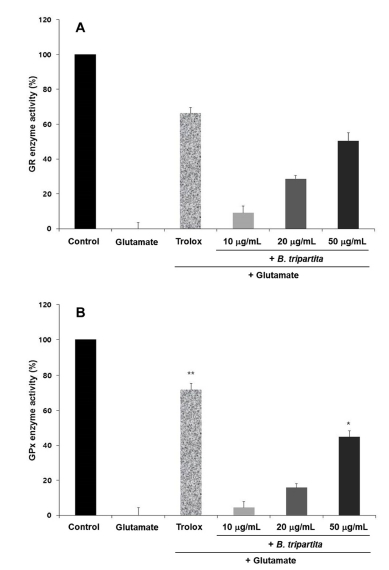
The glutathione related assays of B. tripartita against glutamate toxicity in HT22 cells. GR enzyme activity (A) and GPx enzyme activity (B) was measured. Cells were pretreated with 10, 20, and 50 μg/mL of B. tripartita and trolox as positive control. Then 3 mM glutamate was treated after 1 h. Each bar represents the Mean ± S.D. of three independent experiments. *p < 0.05, **p < 0.01, ***p < 0.001 versus glutamate injured cells.
In conclusion, we have confirmed that B. tripartita has cytoprotective effects in experiments. It was also found that ROS and Ca2+ were decreased and mitochondrial membrane potential, activities of GR, GPx were increased. Previous studies shown that B. tripartita contains flavonoids, such as 7-O-glucosides of isookanin and luteolin.11 Flavonoids are secondary metabolites of plants and fungi. This compound has an antioxidant effect, which seems to be the results of B. tripartite.23 These results suggest that B. tripartita may have potential for the prevention and treatment of degenerative brain diseases by reducing apoptosis and protecting neuronal cells from oxidative stress.
References
-
Cheignon, C.; Tomas, M.; Bonnefont-Rousselot, D.; Faller, P.; Hureau, C.; Collin, F. Redox Biol. 2018, 14, 450–464.
[https://doi.org/10.1016/j.redox.2017.10.014]

-
Shal, B.; Ding, W.; Ali, H.; Kim, Y. S.; Khan, S. Front. Pharmacol. 2018, 9, 548.
[https://doi.org/10.3389/fphar.2018.00548]

-
Kang, Y.; Tiziani, S.; Park, G.; Kaul, M.; Paternostro, G. Nat. Commun. 2014, 5, 3672.
[https://doi.org/10.1038/ncomms4672]

-
Wang, R.; Reddy, P.H. J. Alzheimers Dis. 2017, 57, 1041–1048.
[https://doi.org/10.3233/JAD-160763]

-
Mailly, F.; Marin, P.; Israël, M.; Glowinski, J.; Prémont, J. J. Neurochem. 1999, 73, 1181–1188.
[https://doi.org/10.1046/j.1471-4159.1999.0731181.x]

-
Parfenova, H.; Basuroy, S.; Bhattacharya, S.; Tcheranova, D.; Qu, Y.; Regan, R. F.; Leffler, C. W. Am. J. Physiol. Cell Physiol. 2006, 290, C1399–C1410.
[https://doi.org/10.1152/ajpcell.00386.2005]

-
Amin, F. U.; Shah, S. A.; Kim, M. O. Sci. Rep. 2017, 7, 40753.
[https://doi.org/10.1038/srep40753]

-
Zhu, Y.; Carvey, P. M.; Ling, Z. Brain Res. 2006, 1090, 35–44.
[https://doi.org/10.1016/j.brainres.2006.03.063]

-
Kim, S. J.; Jung, H. J.; Hyun, D. H.; Park, E. H.; Kim, Y. M.; Lim, C. J. Biochimie 2010, 92, 927–932.
[https://doi.org/10.1016/j.biochi.2010.03.007]

-
Pivovarova, N. B.; Andrews, S. B. FEBS J. 2010, 277, 3622-3636.
[https://doi.org/10.1111/j.1742-4658.2010.07754.x]

-
Pozharitskaya, O. N.; Shikov, A. N.; Makarova, M. N.; Kosman, V. M.; Faustova, N. M.; Tesakova, S. V.; Galambosi, B. Phytomedicine 2010, 17, 463–468.
[https://doi.org/10.1016/j.phymed.2009.08.001]

-
Tomczykowa, M.; Tomczyk, M.; Jakoniuk, P.; Tryniszewska, E. Folia Histochem. Cytobiol. 2008, 46, 389–393.
[https://doi.org/10.2478/v10042-008-0082-8]

-
Kinney, J. W.; Bemiller, S. M.; Murtishaw, A. S.; Leisgang, A. M.; Salazar, A. M.; Lamb, B. T. Alzheimes Dement (N Y). 2018, 4, 575–590.
[https://doi.org/10.1016/j.trci.2018.06.014]

-
Villa, F. A.; Gerwick, L. Immunopharmacol. Immunotoxicol. 2010, 32, 228–237.
[https://doi.org/10.3109/08923970903296136]

-
Penugonda, S.; Mare, S.; Goldstein, G.; Banks, W. A.; Ercal, N. Brain Res. 2005, 1056, 132–138.
[https://doi.org/10.1016/j.brainres.2005.07.032]

-
Lefort, J. M.; Vincent, J.; Tallot, L.; Jarlier, F.; De Zeeuw, C. I.; Rondi-Reig, L.; Rochefort, C. Nat. Commun. 2019, 10, 2251.
[https://doi.org/10.1038/s41467-019-09958-5]

-
Barzegar, A.; Moosavi-Movahedi, A. A. PLoS One. 2011, 6, e26012.
[https://doi.org/10.1371/journal.pone.0026012]

-
Tang, T. S.; Slow, E.; Lupu, V.; Stavrovskaya, I. G.; Sugimori, M.; Llinás, R.; Bezprozvanny, I. Proc. Nat. Acad. Sci. U S A 2005, 102, 2602–2607.
[https://doi.org/10.1073/pnas.0409402102]

-
Sribnick, E. A.; Del Re, A. M.; Ray, S. K.; Woodward, J. J.; Banik, N. L. Brain Res. 2009, 1276, 159–170.
[https://doi.org/10.1016/j.brainres.2009.04.022]

-
Nicholls, D. G.; Ward, M. W. Trends Neurosci. 2000, 23, 166-174 .
[https://doi.org/10.1016/S0166-2236(99)01534-9]

-
Ward, M. W.; Rego, A. C.; Frenguelli, B. G.; Nicholls, D. G. J. Neurosci. 2000, 20, 7208–7219.
[https://doi.org/10.1523/JNEUROSCI.20-19-07208.2000]

-
Carlberg, I.; Mannervik, B. Methods Enzymol. 1985, 113, 484-490.
[https://doi.org/10.1016/S0076-6879(85)13062-4]

-
Pietta. P. G. J. Nat. Prod. 2000, 63, 1035–1042.
[https://doi.org/10.1021/np9904509]
